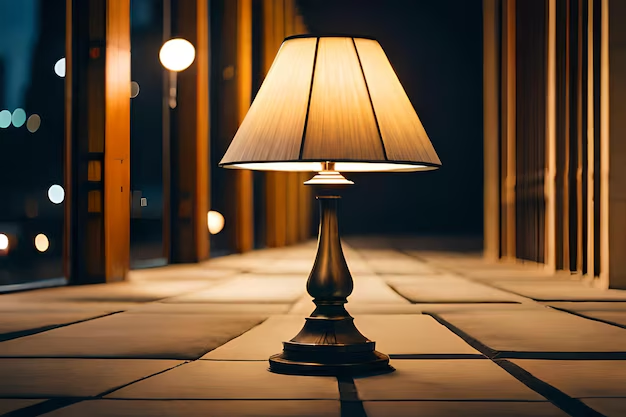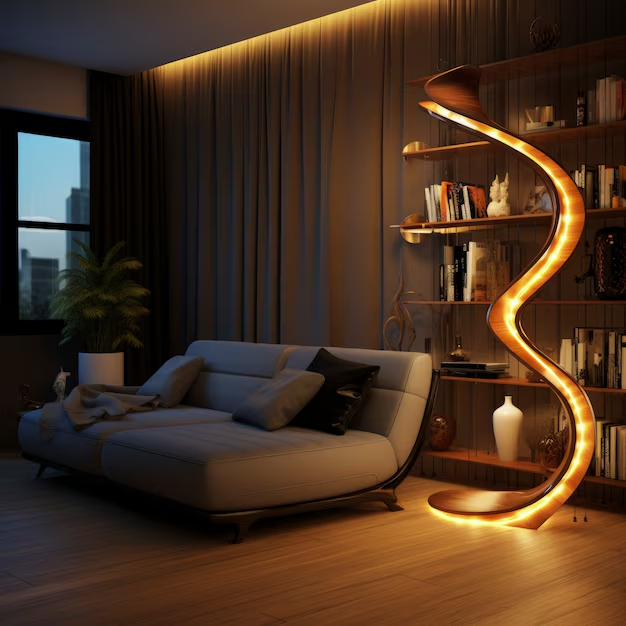Lighting is one of the most important elements in interior design, influencing not only the functionality of a space but also its mood and aesthetic appeal. Lamps, in particular, offer a versatile and stylish way to illuminate your home. They are not just sources of light; they can also be powerful design statements that enhance the ambiance of a room, highlight architectural features, and complement your decor. In this blog, we’ll explore creative ways to use lamps in your interior design, showing how you can transform your space with the right lighting choices.
1. Create Focal Points with Statement Lamps
One of the most effective ways to use in your interior design is to make them a focal point in the room. Statement , with their bold designs and striking presence, can draw attention and anchor a space.
- Oversized Floor Lamps: Consider using an oversized floor lamp in a living room or bedroom to create a dramatic focal point. These can serve as both a functional light source and a piece of art. Place it next to a sofa, in a reading nook, or even in an empty corner to fill the space with both light and visual interest.
- Artistic Table Lamps: Table with unique designs or artistic bases can also serve as focal points. Look for with sculptural elements, vibrant colors, or unusual shapes that stand out. Position them on a console table, bedside table, or a sideboard to add a touch of creativity to your space.
2. Layer Your Lighting for Depth and Dimension
Layering your lighting is a key principle in interior design, helping to create depth, dimension, and a more dynamic atmosphere. By using a combination of different types of lamps, you can achieve a well-balanced and inviting space.
- Ambient Lighting: Start with ambient lighting, which provides overall illumination for the room. This can be achieved with ceiling fixtures, but lamps play an important role in adding warmth and softness to the ambient light. For example, use floor lamps or large table lamps to fill the room with light without relying solely on overhead lighting.
- Task Lighting: Task lighting is focused light that helps you perform specific tasks, such as reading, cooking, or working. Desk lamps, reading lamps, and under-cabinet lighting in kitchens are common examples. Place task lamps where you need direct light, such as on a desk, next to a reading chair, or on a kitchen counter.
- Accent Lighting: Accent lighting highlights specific areas or features in a room, such as artwork, architectural details, or decorative objects. Small table lamps, wall sconces, and even certain types of floor lamps can serve as accent lighting. Use them to draw attention to your favorite pieces or to create a cozy atmosphere by illuminating dark corners.
3. Use Lamps to Define Zones in Open Spaces
In open-concept spaces, lamps can be used to define different zones and create a sense of separation without the need for walls. This is particularly useful in modern homes where living, dining, and kitchen areas often flow into one another.
- Floor Lamps for Seating Areas: Use floor lamps to define seating areas in an open-plan living room. Position a floor lamp next to a sofa or armchair to create a distinct reading or relaxation zone. This not only adds light but also visually separates the seating area from the rest of the space.
- Pendant Lamps Over Dining Tables: Pendant lamps are ideal for defining dining areas in open spaces. Hang a pendant lamp directly above the dining table to create a focal point and establish the area as a distinct zone within the larger room. Choose a pendant lamp with a design that complements the overall decor while also making a statement on its own.
- Table Lamps on Consoles and Sideboards: In open spaces, use table on consoles, sideboards, or buffets to define transitional areas, such as entryways or the space between the living and dining areas. These not only provide light but also help create a sense of flow and continuity between different zones.
4. Incorporate Lamps as Decorative Elements
Lamps are not just functional; they can also serve as decorative elements that enhance the overall aesthetic of a room. By choosing lamps that align with your interior style, you can add an extra layer of design to your space.
- Vintage and Antique Lamps: Incorporate vintage or antique lamps into your decor for a touch of history and character. These lamps often feature intricate designs, unique materials, and craftsmanship that add a sense of timelessness to a room. Place them in prominent spots, such as on a mantel, side table, or dresser, where they can be appreciated as decorative objects.
- Modern Sculptural Lamps: For a contemporary look, consider modern sculptural lamps that double as art pieces. These often feature geometric shapes, abstract designs, and innovative materials. Use them in minimalist or modern interiors to add a touch of sophistication and creativity.
- Lamps with Natural Materials: made from natural materials like wood, stone, or ceramic can add texture and warmth to a space. These are perfect for adding a touch of organic beauty to a room, especially in spaces with a rustic, bohemian, or Scandinavian design aesthetic.
5. Mix and Match Lamp Styles for Eclectic Appeal
Don’t be afraid to mix and match different lamp styles to create an eclectic and personalized look. Combining various lamp designs can add visual interest and prevent a room from feeling too uniform or predictable.
- Pairing Modern and Traditional Lamps: Combine modern and traditional lamp styles to create a dynamic contrast. For example, pair a sleek, contemporary floor lamp with a classic, ornate table lamp to add depth and character to your space. This mix of styles can also help to blend old and new elements in a room, creating a cohesive yet eclectic look.
- Mixing Colors and Finishes: Experiment with in different colors and finishes to add variety and interest to your decor. For instance, you might combine a brass floor lamp with a ceramic table lamp in a bold color. This approach works particularly well in spaces with a neutral color palette, where the can add pops of color and texture.
- Varying Lamp Heights and Sizes: Play with different lamp heights and sizes to create a layered and dynamic look. Place a tall floor lamp next to a shorter table lamp, or use small accent alongside larger, more imposing pieces. This variation in scale adds visual rhythm and can help to balance the proportions of a room.
6. Use Lamps to Highlight Architectural Features
Lamps can also be used to highlight and enhance architectural features in your home. Whether you have a beautifully designed fireplace, an alcove, or a vaulted ceiling, lamps can draw attention to these elements and make them stand out.
- Up-lighting with Floor Lamps: Use floor with upward-facing lights to illuminate architectural features like vaulted ceilings, beams, or large wall spaces. This type of lighting creates a dramatic effect, emphasizing the height and structure of the room.
- Highlighting Fireplaces: Place on either side of a fireplace to frame it and draw attention to this central feature. Choose lamps that complement the style of the fireplace, whether it’s modern, traditional, or rustic. The warm glow from the will enhance the cozy ambiance of the space.
- Illuminating Shelving and Niches: Use small accent to highlight built-in shelving, niches, or display cabinets. These lamps can draw attention to decorative objects, books, or artwork displayed on the shelves, adding depth and interest to the space.
Conclusion
Lamps are more than just practical lighting solutions—they are essential design elements that can transform the look and feel of a room. By creatively incorporating lamps into your interior design, you can enhance the ambiance, define spaces, and add unique style to your home. Whether you’re looking to create a cozy reading nook, highlight architectural features, or simply add a touch of elegance to your decor, the right lamp can make all the difference. So, experiment with different lamp styles, placements, and lighting techniques to find the perfect balance of function and beauty in your space.


